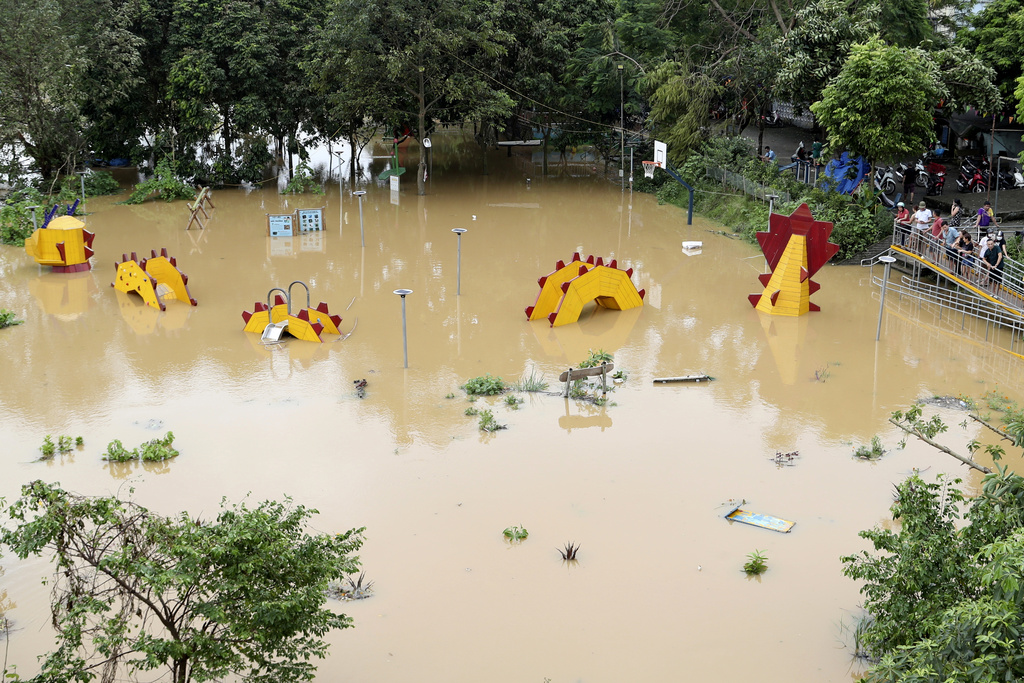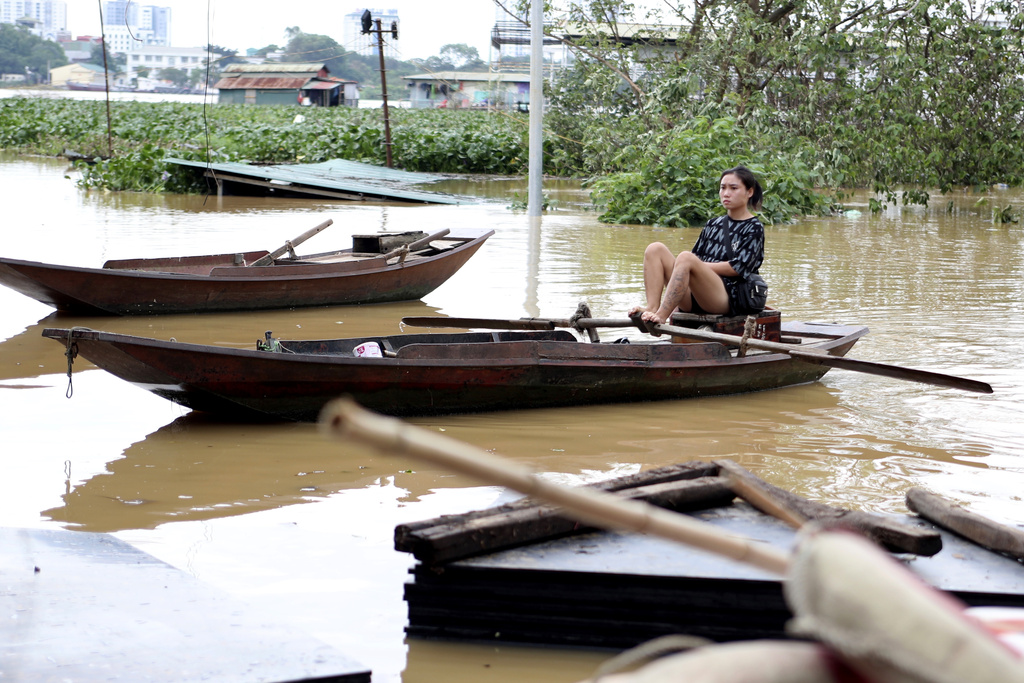Flash Flood in Vietnam Kills 16, Dozens Still Missing \ Newslooks \ Washington DC \ Mary Sidiqi \ Evening Edition \ A flash flood in northern Vietnam wiped out Lang Nu hamlet, killing 16 people and leaving around 40 others missing, as Typhoon Yagi’s devastation continued. The storm, the strongest to hit the country in decades, has claimed 141 lives so far, with dozens still missing. Rescue operations are underway, but ongoing rains and difficult terrain are hindering efforts.

Vietnam Flash Flood Quick Looks
- Flash flood disaster: A sudden flood in Lao Cai province has killed 16 and left dozens missing.
- Lang Nu hamlet destroyed: A torrent of mud and debris buried the hamlet, home to 35 families.
- Typhoon Yagi’s toll: The typhoon has led to widespread flooding and landslides, with 141 people confirmed dead.
- Rescue efforts ongoing: Authorities are searching for approximately 40 missing residents in the aftermath.
- Severe weather continues: Despite Typhoon Yagi weakening, heavy rains and high river levels persist, raising fears of further floods and landslides.
Deep Look
A devastating flash flood in northern Vietnam has swept through the remote Lang Nu hamlet in Lao Cai province, claiming the lives of at least 16 people and leaving around 40 others unaccounted for. The flood was triggered by torrential rains brought on by Typhoon Yagi, which made landfall on Saturday and has continued to batter the region with unrelenting downpours. As of Wednesday, the death toll from typhoon-related flooding and landslides across northern Vietnam has risen to 141, with 69 people still missing and hundreds more injured.
A Hamlet Swept Away
Lang Nu hamlet, home to 35 families, was almost completely buried by mud and debris as the flash flood surged down from the mountains. The floodwaters, swollen by heavy rains, hit the village with little warning, sweeping away homes, livestock, and infrastructure. While about a dozen residents managed to survive the disaster, the search for others is ongoing, with rescuers facing challenging conditions as they comb through the mud and wreckage.
According to reports from Vietnamese state broadcaster VTV, rescue teams have so far recovered 16 bodies, and authorities fear that the death toll could rise as efforts to locate the missing continue. The rugged and remote terrain of Lao Cai province has made rescue operations slow and difficult, with roads cut off by flooding and landslides in many areas.
Flash Flood in Vietnam :Typhoon Yagi’s Widespread Devastation
Typhoon Yagi, the strongest storm to hit Vietnam in decades, made landfall on Saturday with winds reaching up to 149 kph (92 mph). Although the storm weakened after coming ashore, it unleashed torrential rainfall across northern Vietnam, triggering floods and landslides in mountainous areas. Rivers throughout the region have swollen to dangerous levels, and many villages, like Lang Nu, have been left vulnerable to sudden flash floods.
The extent of the damage caused by Typhoon Yagi is becoming clearer as rescue and recovery operations continue. In addition to the loss of life, the storm has displaced thousands of people, destroyed homes, and left entire communities cut off from basic services like clean water and electricity.
With 141 confirmed dead, the toll from Typhoon Yagi’s impact is one of the highest seen in Vietnam in recent years. The storm has also caused extensive damage to infrastructure, including roads, bridges, and power lines, complicating efforts to reach affected areas and provide emergency relief.
Climate Change and Extreme Weather in Southeast Asia
Typhoon Yagi is the latest in a series of severe storms to strike Southeast Asia, a region that is becoming increasingly vulnerable to extreme weather events as a result of climate change. Rising sea levels and higher global temperatures are contributing to the intensity and frequency of typhoons and other natural disasters in the area. Vietnam, with its long coastline and mountainous interior, is particularly exposed to these threats, and storms like Yagi are expected to become more common in the coming years.
In recent years, Vietnam has experienced a rise in the number of destructive typhoons and floods, causing significant loss of life and economic damage. The country’s disaster response system, while improving, continues to face challenges in dealing with the scale and intensity of these events. Remote and rural areas, such as Lao Cai province, are often the hardest hit, with limited access to emergency services and infrastructure.
Search and Rescue Operations Hampered
Efforts to rescue those missing in Lang Nu and other affected areas are being hampered by the ongoing heavy rains and difficult terrain. Floodwaters have blocked roads and washed away bridges, making it difficult for rescue teams to reach some of the worst-hit regions. Landslides are also a major concern, with several incidents reported in the days following the typhoon.
Despite these challenges, search and rescue operations are continuing. Local authorities and military personnel have been mobilized to help find survivors and provide aid to displaced residents. Helicopters have been deployed in some areas to airlift supplies to isolated villages, and boats are being used to navigate flooded roads and rivers.
However, with 69 people still missing across northern Vietnam, the prospects of finding more survivors are becoming increasingly bleak. Many of the missing are believed to have been buried under landslides or swept away by floodwaters, and authorities fear that the final death toll could be significantly higher.
Flash Flood in Vietnam Long-Term Recovery Challenges
As the immediate threat from Typhoon Yagi begins to recede, the focus will shift to recovery and rebuilding efforts in the affected regions. The destruction of homes, infrastructure, and farmland means that many communities will be facing a long road to recovery. In some areas, entire villages will need to be relocated to safer ground, and the cost of rebuilding is expected to be substantial.
For the families in Lang Nu hamlet and other affected areas, the emotional and psychological toll of the disaster will also be significant. Many have lost loved ones, homes, and livelihoods in the floods, and the process of rebuilding their lives will be challenging.
The Vietnamese government has pledged to provide assistance to those affected by the floods, and international aid organizations are also expected to play a key role in the recovery process. However, with climate change increasing the likelihood of future disasters, long-term solutions will be needed to protect vulnerable communities from the growing threat of extreme weather events.
Conclusion
The flash flood that swept through Lang Nu hamlet in northern Vietnam is a tragic reminder of the devastating power of nature and the increasing risks posed by climate change. As Typhoon Yagi’s death toll continues to rise, the country faces the dual challenges of rescuing those still missing and beginning the long process of recovery. For now, the focus remains on finding survivors and providing relief to the thousands affected by this catastrophic event.







